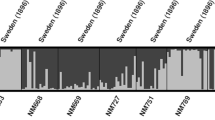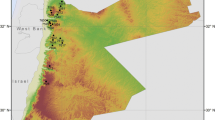Abstract
Apart from their significance in genetic conservation, barley landraces are still favoured by local farmers in low-input farming systems. They often perform more predictably under adverse conditions than modern cultivars due to local adaptation. Increased seed exchange between farmers may put adaptation of local populations of barley landraces at risk. Isozyme markers were used to investigate differentiation and infer gene flow between local populations of barley landrace Arabi Aswad in Northern Syria. Inferred gene flow decreased exponentially with geographic distance and may imply that seed exchange between farmers is limited to a regional scale and diminishes over longer distance. Gene flow seems to be a suitable index for estimating seed exchange in highly inbreeding crop species such as barley. In the future, improved mobility of farmers and extension work may facilitate seed exchange over longer distances, and consequently jeopardise preservation of locally adapted landraces in barley.
Similar content being viewed by others
References
Allard R.W. 1992. Predictive methods for germplasm identification. In: Stalker H.T. and Murphy J.P. (eds), Plant Breeding in the 1990's. CAB International, Wallingford, pp. 119–133.
Brown A.H.D. 1983. Barley. In: Tanksley S.D. and Orton T.J. (eds), Isozymes in Plant Genetic Breeding. Elsevier Science Publishers B.V., Amsterdam, pp. 57–77.
Brown A.H.D. and Munday J. 1982. Population genetic structure and optimal sampling of landraces of barley from Iran. Genetica 58: 85–96.
Ceccarelli S. 1996. Adaptation to low/ high input cultivation. Euphytica 92: 203–214.
Cheliak W.M. and Pitel J.A. 1984. Techniques for starch gel electrophoresis of enzymes from forest tree species: Information report PI-X-42. Petawawa National Forestry Institute.
Epperson B.K. 1990. Spatial patterns of genetic variation within plant populations. In: Brown A.H.D., Clegg M., Kahler A.L. and Weir B.S. (eds), Plant population genetics, breeding and genetic resources. Sinauer, Sunderland, USA, pp. 229–253.
Falconer D.S. and Mackay T.F.C. 1996. Introduction to quantitative genetics. 4th edn. Longman, Harlow.
Hammer K., Leymann Chr.O. and Perrino P. 1985. Character variability and evolutionary trends in a barley hybrid swarm – a case study. Biologisches Zentralblatt 104: 511–517.
Hamrick J.L. and Godt M.J.W. 1990. Allozyme diversity in plant species. In: Brown A.H.D., Clegg M.T., Kahler A.L. and Weir B.S. (eds), Plant population genetics, breeding and genetic re-sources. Sinauer, Sunderland, USA, pp. 43–63.
Harlan J. 1975. Our vanishing genetic resources. Science 188: 618–621.
Jana S. and Pietrzak N. 1988. Comparative assessment of genetic diversity in wild and primitive cultivated barley in a center of diversity. Genetics 119: 981–990.
Kahler A.L. and Allard R.W. 1970. Genetics of isozyme variants in barley. I. Esterases. Crop Science 10: 444–448.
Kahler A.L., Heath-Pegliuso S. and Allard R.W. 1981. Genetics of isozyme variants in barley. II. 6-Phosphogluconate Dehydrogenase, Glutamate Oxalate Transaminase, and Acid Phosphatase. Crop Science 21: 536–540.
Goldenberg E.M. 1987. Estimation of gene flow and genetic neighbourhood size by indirect methods in a selfing annual, Triticum dicoccoides. Evolution 41: 1326–1334.
Nei M. 1987. Molecular evolutionary genetics. Columbia University Press, New York, Guildford.
Nevo E. 1992. Origin, Evolution, Population Genetics and Re-sources of Wild Barley, Hordeum spontaneum, in the Fertile Crescent. In: Shewry P.R. (ed.), Barley: Genetics, Biochemistry, Molecular Biology and Biotechnology. CAB-International, Wallingford, UK, pp. 19–43.
Parzies H.K., Spoor W. and Ennos A.R. 2000. Outcrossing rates of barley landraces from Syria. Plant Breeding 119: 520–522.
Ramamoorthy J., Chong D.K. and Chinappa C.C. 1994. Comparative Assessment of genetic diversity in wild and cultivated barley using ribosomal DNA spacer length variants. Israel Journal of Plant Sciences 42: 115–123.
Slatkin M. 1993. Isolation by distance in equilibrium and non-equilibrium populations. Evolution 47: 264–279.
Van Leur J.A.G., Ceccarelli S. and Grando S. 1989. Diversity for disease resistance in barley landraces from Syria and Jordan. Plant Breeding 103: 324–335.
Weltzien E. 1982. Observation on the growth habit of Syrian and Jordanian landraces of barley. Rachis 1: 6–7.
Weltzien E. 1989. Differentiation among barley landrace popula-tions from the Near East. Euphytica 43: 29–39.
Yeh F.C., Yang R.-C., Boyle T.B.J., Ye Z.-H. and Mao J.X. 1997. POPGENE, the user-friendly shareware for population genetic analysis. Molecular Biology and Biotechnology Centre. Molecu-lar Biology and Biotechnology Centre, Canada.
Author information
Authors and Affiliations
Corresponding author
Rights and permissions
About this article
Cite this article
Parzies, H., Spoor, W. & Ennos, R. Inferring seed exchange between farmers from population genetic structure of barley landrace Arabi Aswad from Northern Syria. Genetic Resources and Crop Evolution 51, 471–478 (2004). https://doi.org/10.1023/B:GRES.0000024157.67531.88
Issue Date:
DOI: https://doi.org/10.1023/B:GRES.0000024157.67531.88




